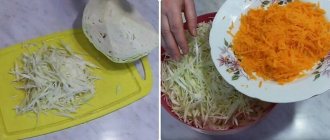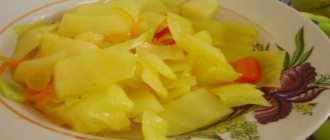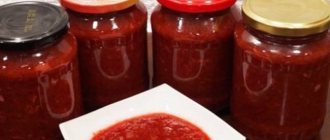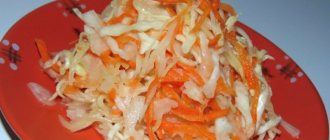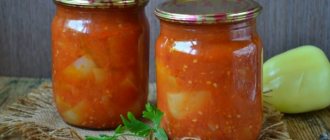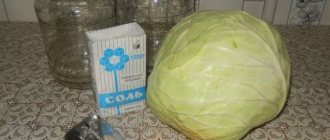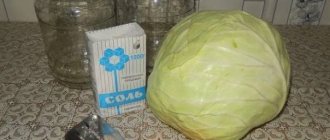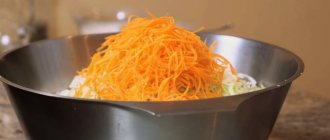Recipe Variations
There are many ways to prepare sweet sauerkraut at home. Some of them include unusual ingredients. Below are the best recipes.
Fast way
The appetizer prepared according to this recipe is eaten within a few hours after salting. This salad is not suitable for preparing for the winter - it can be stored for no more than a week in the refrigerator.
Ingredients:
- cabbage – 3-4 kg;
- garlic – 6 cloves;
- odorless sunflower oil – 0.5 cups;
- table or apple vinegar – 0.5 cups;
- sugar – 7 tbsp. l.;
- salt – 8 tbsp. l.;
- water – 0.5 l;
- carrots – 3 pcs.
The amount of salt and sugar is adjusted to suit your taste.
How to make a quick delicious cabbage snack:
- The cabbage is peeled from the top leaves and finely chopped. Carrots are washed, peeled and grated on a Korean vegetable grater. The garlic is finely chopped or passed through a special press.
- Vegetables are mixed in an enamel pan. They are crushed to release the juice.
- The water is brought to a boil. Vegetable oil and vinegar are poured into it, sugar and salt are added. The brine is boiled until the sugar and salt dissolve.
- Vegetables are poured with hot brine. A wooden circle and oppression are placed on top.
- The salad is marinated at room temperature. It will be ready for use in 3 hours. After a day, its taste will be more intense.
Ready pickled vegetables are stored in the refrigerator in glass jars.
In its own juice
Sauerkraut in its own juice is prepared using a dry method. This recipe is considered the most useful. It contains a minimum of ingredients.
Ingredients:
- cabbage – 5 kg;
- sugar – 4 tbsp. l.;
- salt – 2 tbsp. l.;
- carrots – 4 pcs.
This recipe will require some pressure. It is what promotes the release of juice from vegetables.
How to ferment cabbage in your own juice:
- The top green leaves are removed and washed. They cover the bottom of the container in which the cabbage will be salted.
- The head of cabbage is washed and finely chopped. Carrots are washed, peeled and grated.
- Mix vegetables in a separate container. Add salt to them and mash until the ingredients release their juice.
- The vegetables are transferred to a container where they will ferment, compacting thoroughly. A wooden stand and oppression are placed on top.
The fermentation process continues for 2-3 days, then the vegetables are transferred to the refrigerator.
With vinegar and beets
Cabbage cooked with beets according to this recipe has an unusual light burgundy color and looks original in the photo. Beets add a specific taste and make the dish healthier.
Ingredients:
- cabbage – 5 kg;
- red beets – 5 small roots;
- table vinegar – 5 tbsp. l.;
- water – 1.5 l;
- bay leaf – 6 pcs.;
- salt – 2 tbsp. l.;
- sugar – 3 tbsp. l.;
- black pepper – 10 peas.
Salad prepared according to this recipe can be stored in a cold place for up to a month.
How to cook:
- The cabbage is washed and removed from the top leaves. It is finely chopped or cut into squares.
- The beets are washed and cleaned. Then cut into thin slices or grate on a coarse grater.
- Mix vegetables in the container where the appetizer will be prepared. You need to mash them a little so that the juices mix.
- The water is brought to a boil. Sugar, salt, bay leaf and peppercorns are added to it. The mixture is boiled for 10 minutes. Then add vinegar and boil for another 2 minutes.
- Pour the brine over the vegetables. Cover the container with gauze and leave in a warm place for 2-3 days.
Beetroot juice is difficult to wash off your hands. Therefore, it is recommended to wear disposable gloves when working with this vegetable.
In honey brine
This method of cooking with honey will appeal to lovers of unusual combinations. Honey and a set of spices give the salad an unusual taste.
Ingredients:
- cabbage – 5 kg;
- apples – 3 pcs.;
- carrots – 2 pcs.;
- water – 1.5 l;
- cumin – 1 tsp;
- honey - 4 tbsp. l.;
- salt – 1.5 tbsp. l.
If desired, black and allspice peas are added to the appetizer. They will make the dish more spicy.
Cooking method:
- The cabbage is washed, peeled from the top leaves and finely chopped. The carrots are peeled and grated on a coarse grater. The apples are peeled and cored and also grated on a coarse grater.
- Mix vegetables in a separate deep container. Cumin and salt are added to them. The ingredients are mashed by hand until the juice is released. The vegetables are transferred to a container where they will be marinated.
- Honey is dissolved in warm, purified or boiled water. After the brine has cooled completely, pour the vegetable mixture over it. A wooden circle and oppression are placed on top.
Green apples work best for this recipe. An ideal option is the Antonovka variety.
Crispy pickled cabbage with pepper as a salad for the winter
This spicy dish with sweet and sour taste is a real vitamin bomb!
- two kilos of cabbage;
- large ripe bright bell pepper with thick walls;
- two carrots;
- head of garlic;
- 1 tbsp salt;
- half a glass of sugar;
- 1 table l vinegar;
- sugar 3 tbsp;
- a quarter teaspoon each of ground black pepper, red hot pepper and coriander;
- two full glasses of water.
- We clean, wash and chop the vegetables, mix them in an enamel bowl or pan.
- Cook the marinade by mixing the remaining ingredients, except for acetic acid, which we pour in after the marinade boils.
- Pour the marinade over the vegetables and stir.
- Place the salad in sterile jars and place in the refrigerator. After 12 hours the sample can be taken.
Keeps in the refrigerator for up to two to three weeks. Bon appetit!
Classic recipe for sauerkraut with brine at home
There are two main options for preparing sauerkraut: with brine and without it. Every housewife gives preference to one of them. And to understand what is best for you, you need to try both methods.
When fermenting with brine, you do not need to grind it with salt and crush the fruit too much. That is, this is a physically easier recipe. And it requires 4 main components. Those who want to balance the sour taste add sugar, but this is optional.
Ingredients for a 3 liter jar:
- late white cabbage – 2.5 kg
- carrots - 1 pc. average
- salt - 2.5 tbsp.
- sugar - 2 tbsp. without slide (optional)
- clean water without chlorine - 1.5 l
Cooking steps:
1. Cabbage should be chopped not too thin, into medium pieces. This is done in any convenient way: with a sharp knife, a shredder, or on a special grater.
2. Peel the carrots and grate on a coarse grater. Add to the white cabbage.
3.Mix the two main vegetables, without pressing or mashing.
4. Wash the jar with soda and dry. Fold the vegetable mixture into it, compacting it so that it fits more tightly. But you don’t need to try too hard to get the juice out in this recipe. For convenience, you can use a potato masher or rolling pin.
5.Fill a three-liter jar to the neck.
6. All that remains is to prepare the brine. For this, take clean drinking water, bottled or from a natural source. Add salt and sugar if you like. Stir until all the crystals dissolve.
7. Pour the resulting brine over the cabbage. The liquid should completely cover the vegetables. If it is not enough, you can add clean water as needed. Take salt at the rate of 1 tbsp. per 1 kg of the main product.
8.Place the jar in a deep plate and cover the reverse side with gauze or a plastic lid. Leave the cabbage to ferment at room temperature for 3 days. The warmer the room, the faster the product will ferment. This can happen in two days.
9.The next day, be sure to pierce the cabbage morning and evening to the very bottom in several places with a wooden stick. This is done so that the formed carbon dioxide comes out. In this case, the brine will sink to the bottom. Pour the leaked juice into the plate back into the jar. Pierce the workpiece all days of fermentation. If you don't do this, the snack will turn out bitter.
10.In about three days, the active phase will end. The brine will no longer rise and flow out, it will become almost transparent, not cloudy, and bubbles will not come out when pierced. Now you can close the jar tightly with a lid and put it in the refrigerator or basement for storage.
11. The result is very tasty, juicy cabbage. Sourish, but without bitterness. The easiest way to serve is to add fresh onions and sunflower oil. You can also add sour cranberries or currants.
How to make pickled cabbage crispy
In order for the vegetable to be crispy and juicy, you need to use strong heads of cabbage of medium-late ripening, and also adhere to the rules of cooking technology.
Cooking tips:
- For cooking, use only tight forks.
- It is not recommended to use young cabbage.
- To create a unique recipe, you can add herbs and spices to the brine.
- Pickled cabbage goes well with berries, fruits and other vegetables.
- Table vinegar can be replaced with apple, grape, or lemon juice.
- You need to marinate in glass, enamel or plastic containers, since the brine tends to oxidize.
Cabbage for the winter in jars with aspirin
Pickling vegetables often involves the use of natural and other preservatives to help preserve the taste and consistency of the product.
For example, this is how cabbage is pickled for the winter with aspirin in jars, when a well-known medicine is used for long-term storage of cabbage.
Let's learn how to pickle everyone's favorite vegetable using acetylsalicylic acid according to different recipes at home.
Why do you need aspirin when pickling cabbage?
Marinating cabbage with aspirin is carried out for the following purposes:
- Aspirin acts as a preservative that extends the shelf life of the finished product. Cabbage does not mold, does not ferment, and remains fresh for a long time (more than six months) even when stored indoors.
- Aspirin speeds up the marinating process. Jars and lids for storing cabbage with acetylsalicylic acid do not need to be sterilized, which significantly saves time.
- Aspirin preserves the consistency of cabbage. The cabbage remains crisp and juicy and retains its original color.
Opinions differ regarding the safety of aspirin for health: some believe that there are already plenty of drugs in our lives, and it is unnecessary to flavor cabbage with aspirin. Others are confident in the absolute safety of this method of pickling and have been using it for several years.
If you want to try this method, we’ll find out how to marinate cabbage for the winter with aspirin.
Cabbage with aspirin for the winter: recipe with carrots
What ingredients do we need to pickle cabbage in a three-liter jar:
- Cabbage - as much as will fit in the jar;
- A couple of carrots;
- 3 tablespoons of coarse salt;
- 3 tablespoons granulated sugar;
- 3 aspirin tablets;
- 3 bay leaves;
- 6 black peppercorns.
How to cook pickled cabbage with aspirin
Aspirin was added to cabbage and other preparations by our grandmothers, who experienced a shortage of our usual preservatives. Cabbage, tomatoes and cucumbers were marinated with it. To try cabbage for the winter in jars with aspirin according to my grandmother’s recipe, we will follow this plan:
- Remove the top leaves from the heads of cabbage and chop the cabbage.
- Three washed carrots using a coarse grater.
- Mix the chopped carrots and cabbage, thoroughly turning the mixture with your hands.
- Pour boiling water over the jar, add a third of sugar, salt, peppercorns, add a bay leaf and a tablet of acetylsalicylic acid.
- Fill half the jar with the cabbage-carrot mixture, tamp it down and repeat adding the ingredients a couple more times.
- Pour boiling water up to the shoulders, after 5 minutes. add boiling water to the top and roll up (twist).
We turn the jar over, wait until it cools down, and put it in a cool place. We use pickled cabbage as an independent dish, a filling for pies or a side dish for meat dishes.
Pickled cabbage for the winter with aspirin and spices
To marinate cabbage with aspirin, you need the following components:
- Half a head of white or red cabbage;
- 7 anise seeds;
- Hot pepper;
- A teaspoon each of ginger powder, mustard seeds and fennel seeds;
- 3 tablespoons salt;
- Aspirin tablet.
How to prepare cabbage with aspirin for the winter
Herbs and spices, taken in the proportions recommended in the recipe, will give the cabbage a delicate spicy smell and piquant taste. And aspirin will allow you to enjoy cabbage until spring.
Let's marinate it according to the following recipe:
- Having removed the top and damaged leaves from half a head of cabbage, chop it, fill it with a liter of water, add salt, mix and leave overnight.
- In the morning, completely drain the juice using a colander, which will take about a couple of hours.
- Turn on low heat, place a dry frying pan and stove and heat the spices until the oils are released. Pour in water (0.5 l), wait until it boils, and add hot pepper.
- Place the cabbage in a jar, fill it with spicy marinade and roll it up.
We taste pickled cabbage with aspirin after a month. It will not change color and will turn out so tasty that it is suitable as a snack for everyday and holiday tables.
So, you have learned how to prepare cabbage for the winter in jars with aspirin according to several recipes. Try making this cabbage yourself, and you will provide yourself with a delicious crunchy snack that even children like until spring!
Recipe for preparing a winter snack - cabbage with aspirin in jars, why you need to add tablets, preparing a dish with carrots and spices
How to roll cucumbers with aspirin and citric acid
Canning with citric acid is also popular among housewives. It is used instead of vinegar when the characteristic aroma of the essence is not liked. The cucumbers are pickled, with a slight pleasant sourness.
Take for a three-liter jar:
- Vegetables – 2 kg.
- Aspirin – 3 tablets.
- Bay leaf - a pair of leaves.
- Citric acid – 2 small spoons.
- Peppercorns – 6-8 pcs.
- Garlic cloves – 6 pcs.
- Sugar – 2 tablespoons.
- Salt – 3 tablespoons.
- Dill, horseradish, add parsley if desired.
How to marinate:
- Soak the cucumbers, remembering to trim the ends.
- Place the seasonings specified in the recipe into a sterilized jar.
- Add cucumbers and chopped garlic. Pour boiling water over it and let stand so that the vegetables have time to warm up.
- Pour the infusion into a saucepan, add salt and sugar. Boil until the spices have dispersed. Add citric acid.
- Pour the marinade into the vegetables, add an acetylsalicylic acid tablet under the lid. Screw on the cylinders (you can use a screw or iron cap).
- Turn over, cover warmly, let cool. Then check the tightness of the workpiece. Place in a cold basement or pantry.
Selection and preparation of cabbage and other ingredients for pickling
Winter varieties of cabbage are used for pickling. These include mid-season and late varieties: Yubileiny Semko, Moscow late, Kharkov winter, Aggressor F1, Amager 611, Valentina F1, Zimovka 1474, Kolobok F1. Late varieties are harvested after the first frost. It is the light frost that gives cabbage leaves their special juiciness and crunch.
Before salting, be sure to remove the top covering leaves from the head of cabbage. They are not suitable for pickling, even if they look good. It is recommended to cut the forks in half to make sure there are no small insects inside or rotten leaves. The stalk is removed. But in some recipes it is needed so that the leaves do not fall apart during processing.
Sweet carrots will do. It should be fresh, bright orange. There is no need to take a very large one, as it may be dry.
You will also need absolutely any granulated sugar if the housewife wants to get a tasty and extraordinary dish. Vinegar is also optional, but if you use it, it is better to replace regular vinegar with homemade wine or apple vinegar.
Spices are taken as follows:
- dill;
- mustard;
- fennel;
- ginger;
- allspice;
- laurel;
- garlic;
- carnation;
- horseradish;
- coriander.
Additionally, the preparations may contain cranberries, beets, apples, plums, lingonberries, mushrooms and other vegetables and berries.
This is interesting: How to prepare pickled watermelons in jars for the winter: recipe and tips for canning
Pickled cabbage for the winter in jars, recipes for iron lids, with aspirin and without sterilization
At the very peak of the time when it is necessary to prepare pickles and twists, many experienced housewives always want their pantry to be filled with such goodies, and they always try to use vegetable reserves to the maximum so that they can enjoy snacks in winter. Thus, every woman has jars of pickled white cabbage in her stock, but for some reason, twists with cauliflower are quite rare in their arsenal.
By the way, cauliflower is twice as rich in vitamin C as the regular type of vegetable. By preparing pickled cauliflower, you will definitely be able to surprise your loved ones and guests, since hardly anyone expects to see such a dish on the table, but do not doubt it, since the appetizer has a fairly bright and pleasant taste. Sealing should be done using iron caps.
In order to please yourself with an unusual snack, you need to take one piece of large-sized cauliflower, several carrots, two red peppers, 3 medium-sized onions, and a liter of water. For spices you will need to take two teaspoons of salt, eight peas of black pepper, two tablespoons of sugar, five cloves, two teaspoons of vinegar, two bay leaves.
In order to start the cooking process, you first need to wash the cabbage and disassemble it into separate parts, cut the carrots into slices. After which it is necessary to remove the insides of the sweet pepper, and, accordingly, cut it in a convenient way, peel the onion and cut it into several parts.
When all the dishes have lids, you need to place the cabbage in the pantry or cellar. You can also place the twists in the refrigerator until winter sets in. But, if you really want to enjoy a delicious dish, you can open the jar after a few days and try your creation.
Another option for cooking cabbage with aspirin
For the third recipe we will need the following components:
- head of white cabbage;
- one carrot;
- three tablespoons each of granulated sugar and salt;
- three or four bay leaves;
- ten black peppercorns;
- ten inflorescences of a whole carnation;
- three aspirin tablets.
We clean and chop the vegetables in the usual way. Then they are ground to release the juice. The mixture is poured into half-liter jars. Pour a third of a tablespoon of sugar and the same amount of salt, a peppercorn and bay leaf into the bottom of each container.
Important! Add half a tablet of aspirin to a half-liter jar. Since we lay out the workpiece in layers, a sixth of the whole tablet should be crumbled to the bottom of the jar.
After aspirin, put the vegetable mass into the container; it should fill the jar halfway. Then add spices and aspirin again. The layers are repeated again. You need to put two buds of cloves on top and pour boiling water over the entire contents. The jars are sealed with sterile metal lids. The container with the workpiece is cooled upside down. It is advisable to cover the containers with a warm blanket.
How to salt cabbage in a 3 liter jar at home for the winter
Our grandmothers also knew how to properly ferment and pickle cabbage for the winter. They made sure to use their secrets. Namely, they did salting only when the moon was growing. By the way, dedicated to all lovers of the Lunar calendar, catch the cleaning dates for this year.
In addition, remember the main points:
- Use only non-iodized coarse rock salt for salting and fermenting cabbage. Moreover, make the correct calculation, do not take more than 1 heaped tablespoon per 1 kg of “white cabbage beauty”;
- It is best to prepare cabbage for the winter, when the heads of cabbage are already covered with frost, and choose the varieties that are specifically pickling. Early ones with green leaves are not suitable for this task;
- during the work, you will need to stir the dish so that carbon dioxide is released correctly and there is no large fermentation process and bitterness in the taste;
- The main rule is cooking time. If the appetizer sits in a warm place, its contents will become soft and you won’t feel the crunch at all. Therefore, keep it for 3-5 days, no more, depending on the temperature, be sure to taste it. It should be slightly sour and have an excellent white color. The brine should be light, not cloudy;
- Store workpieces only in the basement, refrigerator, closet or underground. That is, where the temperature is low from 0 to 5 degrees, no more.
Well, now the recipe itself, be sure to take note of it! It is a classic one, and the cabbage is obtained in its own juice, without adding brine. It tastes very juicy, crispy and delicious!
We will need:
Stages:
1. Chop the white cabbage into thin strips with a special knife or do it manually with your hands. Chop the carrots on a coarse grater.
2. Next, according to the plan, the entire mass needs to be salted and sugared.
Why do you think sugar is added? It is necessary for fermentation.
3. After which you need to vainly knead the entire mass with your hands, and it is better to do this not on the work table, but take a deep pan or basin. Do you hear how everything crunches? This is how it should be, after a while you will see more juice.
4. Now load the vegetable mixture into a 3 liter jar. Moreover, do this in parts and compact with your fist or rolling pin until juice appears on top.
5
And by the way, an important condition is that you will need to place a bowl under the jar, as there will be more juice. Wait at room temperature for 3 days, cover the top with gauze or simply place a nylon lid loosely
Moreover, during this time the workpiece must be pierced with a skewer or wooden stick to release carbon dioxide.
6. After 3-5 days, depending on the room temperature, close the workpiece with a nylon lid and put it in the refrigerator for storage or lower it into the cellar. Have a nice adventure!
Well, in winter, serve it with vegetable oil and, of course, chop the onion. Or cook aromatic soups and make bigus, lazy cabbage rolls.
Proven cold salting of cabbage in large pieces
Experience shows that cold pickling of cabbage in large pieces in jars is the most popular method of preserving the product for a long period of time. And the prepared appetizer according to grandma’s recipe will retain all the beneficial properties of the vegetable.
To pickle large pieces you will need:
- 3.5 kg of late grade elastic forks;
- 0.5 kg of fresh beets;
- 3 garlic cloves;
- a small piece of horseradish root (about 5 cm);
- 100 g salt;
- 0.5 tbsp. granulated sugar;
- 5 peppercorns;
- 3-5 laurel leaves;
- 2 liters of water.
Cold cooking:
- The forks are cut into 4 parts.
- The beets are cut into small slices. Garlic and horseradish - into small fractions.
- For the marinade, add spices, salt and sugar to boiled warm water.
- Pieces of garlic and horseradish are laid out at the bottom of the large container; cabbage and beets are laid out on top in dense layers. The workpiece is filled with brine.
- The vegetables are pressed with a lid on which the press is installed, ensuring maximum pressure.
Note to the owner. Since the recipe calls for salting the cabbage without adding vinegar, you shouldn’t expect quick cooking. The fermentation process will take up to 7 days.
The finished product is placed in sterile 1 or 3 liter jars, closed with plastic lids and refrigerated for storage.
Tomatoes and cucumbers for the winter - a finger-licking recipe
I really like this preparation option. I opened the jar, and there were crispy cucumbers on the table and juicy tomatoes flaunting on a plate. The mix turns out above all praise!
Ingredients (for a 3 liter jar):
- Tomatoes
- cucumbers
- Carrot
- Salt - 4 tbsp. spoons (without slide)
- Sugar - 3 tbsp. spoons (heaped)
- Vinegar - 8 dessert spoons
- Garlic - 3-4 cloves
- Black peppercorns - 10 pcs.
- Allspice black pepper - 5 pcs.
- Bay leaf - 3-4 pcs.
- Cloves - 4 pcs.
Cooking process:
1. I do not sterilize jars of vegetables. Therefore, you need to rinse the empty container well and bake it in the oven for 15 minutes.
2. Place an umbrella of dill on the bottom of each jar, then cucumbers and tomatoes. I do not indicate the exact number of vegetables, since it all depends on the size of the fruit and your preferences, as well as availability. For example, I had fewer cucumbers than tomatoes, so the latter will dominate my assortment.
3. Make punctures in each tomato, near the stalk, with a toothpick. The punctures should be deep, half or even the entire length of the fruit. If the punctures are not deep, then there will be no effect - checked! If you don't mind a couple of "wounded" (bursted) vegetables in the jar, you can save time and avoid making holes in the fruit.
4. Place the vegetables tightly in the jar, leaving some room for seasonings.
5. Place a pot of water on the stove and wait for it to boil. Then pour boiling water into jars filled with assorted vegetables and cover with metal lids. According to the recipe, leave for 20 minutes. I’m waiting until the water cools down so that I can pick up the jar and not get burned. Then we put on a nylon lid with holes and pour the infused water back into the pan.
6. When the water starts to boil, add salt and sugar and mix well. Since I don’t have a cellar, I store preserves in the pantry, so my brine is saturated. If your seaming is stored in the cellar, then you can reduce it by 1 spoon (salt 3 spoons, sugar -2).
7. While the marinade is boiling, at this time pour all the spices and 3 carrot wheels into the jar. If you wish, you can add a little horseradish and hot pepper, but I didn’t have either.
8. The marinade has boiled, now add 1 dessert spoon of vinegar essence 70% per 3-liter jar and pour the boiling marinade into the filled jars, up to the very neck. If you only have 9% vinegar at home, then add 8 dessert spoons. Close the lid and seal it tightly with a key.
9. Turn the jars upside down and cover with a warm blanket until cool. Often they stay in this position for a day, and then we put them away in a far corner, where our assortment awaits its time.
Preservation is ready!
A simple recipe for pickled cabbage with cucumbers
Nothing could be simpler!
- a kilo of small cucumbers;
- a kilo of cabbage;
- bell pepper;
- three cloves of garlic;
- dill umbrella;
- five black peppercorns;
- a generous tablespoon of salt;
- dessert spoon of acetic acid.
- We wash and clean the vegetables, cut the forks into large pieces, remove the butts from the cucumbers, and remove the seed chamber from the peppers.
- Place all the vegetables in the jar as tightly as possible, dill, garlic and peppercorns at the bottom of the jar.
- Boil water in a saucepan and fill the jar to the top, let it sit for ten minutes.
- Drain the water into an empty pan and bring it to a boil again, add salt and vinegar.
- Pour the marinade into the jar to the top and roll it up. Cool upside down and store in the cellar.
Simple and tasteful!
Pickled cabbage for the winter in 3 liter jars with iron lids
The recipe is the fastest and simplest, but it turns out very tasty!
Compound:
- cabbage and carrots in the ratio - for a medium fork, 2 medium carrots and three cloves of garlic;
- for marinade for a three-liter jar - half a glass of sugar, two tablespoons of salt, a quarter glass of vegetable oil and a dessert spoon of acetic acid;
- spices: 5 black peppercorns, 4 cloves and a bay leaf per jar.
Preparation:
- We clean the vegetables and chop them - cabbage into small strips, three carrots on a grater, you can use a food processor with interchangeable attachments, the process will go much faster.
- Place garlic, bay leaf, pepper and cloves at the bottom of a sterilized jar.
- Fill the jar with a mixture of cabbage and carrots - you can mix it, or you can layer it - whatever you like.
- Boil an approximate amount of water in a large saucepan so that there is enough to fill all the prepared jars.
- Pour boiling water over the jars under the metal lids and, covering them, let them stand for 10-15 minutes.
- Pour the remaining boiling water out of the pan - we won’t need it anymore.
- Drain the water from the cans into a saucepan and put on heat, add sugar and salt, multiplying the volume by the number of cans.
- Let it simmer a little and add vegetable oil and acetic acid.
- Pour the marinade into the jars, remembering that you need to pour little by little portions into all the jars one by one in a circle so that all the oil does not end up in one jar!
- Roll up the iron lids, turn them over and leave them to cool under the fur coat.
- After cooling, lower it into the cellar.
Bon appetit on a winter evening!
The best and proven recipes for the winter
Use one of the simple recipes.
Classic pickling recipe
You will need to take:
- 3 kilograms of cabbage;
- 6 pieces of carrots;
- 5 liters of water;
- 6 tablespoons salt;
- 2 cups sugar;
- 4 tablespoons homemade vinegar;
- 4 aspirin tablets;
- seasonings and spices to taste.
The cabbage is peeled from the top leaves and cut into pieces as desired. Grate carrots. Everything is mixed by hand so that the juice comes out. Then the cooking method depends on the type (cold or hot).
Cold way
Pour water into a pan, add salt and spices, boil, add vinegar at the very end. Leave for 40 minutes. Then simply pour it up onto the chopped cabbage and cover.
Hot method
Hot-cooked cabbage is placed directly into boiling water and boiled for literally 2 minutes. Add 1 aspirin tablet per 1 liter of composition to each jar. Make punctures to the bottom several times. Close under metal lids.
Recipes for preparing kohlrabi cabbage for the winter with and without sterilization, freezing and storage
Read
Cooking cabbage without vinegar
Have to take:
- 2 kilograms of cabbage;
- 100 grams of carrots;
- 60 grams of sugar and salt;
- spices and seasonings to taste, but always black pepper and bay;
- 3 aspirin tablets.
Prepare the vegetables in the standard way, stir them until the juice releases. Place a three-liter sterilized jar on a clean surface, put a third of salt, sugar and all seasonings on the bottom. Add half of the cabbage and carrot mixture, top with the second third. Repeat the process, sprinkle the remaining seasonings on top. Pour boiling water up to the shoulders, make punctures to the very bottom. Close with metal lids, turn over, wrap and leave until completely cool.
Kvasim vegetable with acetylsalicylic acid
Fermented from a standard number of ingredients. But the peculiarity is that fermentation occurs in its own juice, no water is added. One aspirin tablet is needed per kilogram of mixture.
Assorted carrots
It is better to seal the assortment in jars using the hot method. At the same time, not only carrots are added, but also onions, mushrooms, and bell peppers.
Marinate with seasonings and spices
Pickled cabbage is prepared according to the following algorithm:
- Cut the vegetables into slices of 1 centimeter.
- Alternate with your hands and add carrots.
- Add cloves, pepper, bay.
- Leave for 2 days, releasing air.
After preparation, you need to sterilize the composition and then seal it in jars.
Recipe Variations
There are dozens of ways to pickle cabbage with aspirin. They use different types of cabbage: white, red, cauliflower, Peking cabbage.
Hot method
The hot marinade method helps you quickly roll up a tasty jar of cabbage.
Ingredients for a 3 liter jar:
- white cabbage - 2 kg forks;
- large carrots - 3 pcs.;
- garlic - 6 large cloves;
- black peppercorns - 5 pcs.;
- coarse salt - 2 tbsp. l. with a slide;
- sugar - 1 tbsp. l. with a slide;
- aspirin - 2 tablets of 0.5 g;
- water - 1.5 l.
Salting instructions:
- Sterilize the jar. Boil the metal lid.
- Peeled from the top leaves of the forks, finely chop.
- Carrots are washed, peeled and grated on a coarse grater.
- Mix vegetables in a bowl and knead a little.
- Peel the garlic cloves and cut them in half.
- Place bay leaf, peppercorns, and garlic at the bottom of a hot sterilized jar.
- Boil the brine: water, salt, sugar.
- Grind aspirin tablets into powder.
- Place the vegetable mass tightly and compact each part. Sprinkle with crushed aspirin.
- Pour hot brine over vegetables. It should pour out of the jar when you close the lid.
- They roll up the cans. Turn it upside down to check the quality of the twist.
- After cooling, store in a cool, dark place.
Take note:
Cold way
The composition and proportions of ingredients are the same as with the hot method. The brine consists of water, salt, sugar, and aspirin. It is cooked in advance. Allow time to cool to room temperature.
The vegetable mixture is not crushed, but simply placed in sterilized glass jars.
Fill with cooled brine so that there is no room for air. Roll up with iron lids. Store in a cool, dark place.
Quick Ambassador
You can pickle a quick crispy snack in the following way.
Ingredients for a 3 liter jar:
- white cabbage - 2-3 kg forks;
- carrots - 2 large;
- water - 1.5 l;
- allspice - 5 pcs.;
- bay leaf - 3 pcs.;
- salt - 0.5 tbsp;
- sugar - 1 tbsp;
- vinegar essence - 1 tbsp. l.;
- aspirin - 2 tablets.
Salting instructions:
- Finely chopped cabbage and coarsely grated carrots are mixed, but not crushed.
- Cook the brine: water, salt, sugar, pepper, bay leaf. After boiling, remove from heat and add vinegar.
- The brine is cooled.
- Sterilize the jars and boil the lids.
- Place vegetables in jars, add aspirin, and pour cooled cold brine over them.
- They're rolling up. Store in a cool place.
With garlic
Nutritionists recommend fermenting cabbage with garlic. Regular consumption of such snacks helps normalize metabolism and strengthen the immune system.
Ingredients, proportions for a 3 liter jar:
- white cabbage - 2.5 kg;
- garlic - 3 heads;
- hops-suneli - 1 tbsp. l. without slide;
- coarse salt - 2 tbsp. l. without slide;
- water - 1.5 l;
- curry - 1 tsp.
Salting instructions:
- The cabbage, peeled from the top leaves, is finely chopped.
- Peeled garlic is cut into thin slices.
- Mix cabbage with garlic in a deep container. Add spices (it is not necessary to adhere to the proportions from the recipe, take them to taste).
- Mix everything carefully.
- The resulting mixture is placed in a jar.
- A brine is made from water, salt and sugar.
- Pour hot brine over cabbage. Cover with a lid.
- The workpiece stands at room temperature for 24 hours.
- Cover with a nylon or iron lid. Store in the refrigerator.
Tips from experienced housewives
To pickle delicious cabbage, follow these rules::
- Winter varieties of cabbage are used.
- White cabbage, red cabbage, colored cabbage, and Beijing cabbage are suitable for pickling.
- Salt with medium or coarse table salt. If the remaining impurities after dissolving the coarse salt bother you, then pour the brine through cheesecloth.
- Fans of sea salt should not forget that they add half as much sea salt as table salt.
- For long-term storage, use sterilized glass jars that are sealed with iron lids.
- The pasteurization process increases the shelf life of the product.
Spicy Korean cauliflower for the winter
Spicy and delicious cauliflower can be prepared in Korean style. A bright treat suitable for winter preparations. The product will delight you with its simple cooking process and long-term storage.
Cooking time: 40 minutes
Cooking time: 20 minutes
Servings – 1 l.
Ingredients:
- Cauliflower – 0.5 kg.
- Carrots – 1 pc.
- Chili pepper – 0.5 pcs.
- Garlic – 2 cloves.
- Korean seasoning – 1 tsp.
- Bay leaf – 1 pc.
- Salt – 60 gr.
- Sugar – 150 gr.
- Vinegar – 150 ml.
- Vegetable oil – 50 ml.
- Water – 4 tbsp.
Cooking process:
- Wash the cauliflower, separate it into florets and soak for 15 minutes in a bowl of cold water.
- Next, immerse the product in boiling water for three minutes.
- Place the scalded vegetable in a colander and let the water drain.
- Peel the carrots and grate them onto a Korean carrot grater.
- Finely chop the washed hot pepper.
- In a common bowl, combine all the prepared products. We also add bay leaf, peeled garlic cloves and seasoning for Korean carrots. Mix the contents.
- Separately, boil the water for the marinade and dissolve sugar and salt in it. Then add vinegar and vegetable oil.
- Immerse the vegetable mass in glass jars and fill it with hot marinade.
- We close the blanks with lids, cool them and send them for storage. Ready!
Which cabbage is suitable
Fresh, not spoiled or rotten cabbage is suitable for this recipe. The heads of cabbage should be dense, strong, with juicy, not crushed leaves, without obvious pest damage.
Both regular white cabbage and Beijing cabbage, cauliflower and salad cabbage are suitable for pickling.
White cabbage
The most familiar and proven type of cabbage for pickling for the winter. To do this, it is both chopped and grated; onions, garlic, and carrots are added from other vegetables. Choose mid-late or late varieties that have a much longer shelf life than early ones.
Beijing
It has a more palatable, delicate structure than white cabbage, and pickles much faster. It is prepared both cut into strips and large pieces. One of the most popular and widespread recipes is “Korean-style cabbage.”
For pickling, choose elastic, strong, juicy green heads of cabbage.
Colored
Marinated, crispy Chinese cabbage is used to prepare savory salads, as a side dish for many dishes (especially meat) and is a nutritious, original snack. For cooking, choose strong, dense heads of cabbage that have not begun to bloom, without traces of pests and rot.
Salad
It is similar to regular fermented one, but much tastier, more juicy and crunchy. It is prepared from shredded white cabbage with the addition of carrots, garlic, onions and vegetable oil. Nowadays, the use of leafy cabbage (salad cabbage) is becoming more and more popular, for example, like leafy pak choy or curly cabbage - kale, grunkol.
Pickled cabbage in jars for the winter: 11 best recipes for delicious cabbage
Pickled cabbage for the winter is crispy and spicy, whether it goes with potatoes or meat... and it will go well with soup in the winter!
Our winters are long and harsh, and there are not enough vitamins. And here you have more vitamin C than in a lemon, and a whole carload of other vitamins and mineral elements along with plant acids!
In ancient times, when the Russians did not yet know potatoes, the main food for military squads on a military campaign was bread, cabbage and meat, and in that order.
Look how they fought on cabbage!
Well, we've joked and that's enough, it's time to get down to business. Today we marinate cabbage in three-liter jars, in different ways - both in whole pieces, and in the form of a salad, and we’ll try it with peppers, and with late cucumbers, ripe tomatoes, and we’ll also find a use for apples with carrots and beets.
Wash the jars thoroughly in advance with soda, rinse until transparent under running water and sterilize. Personally, I sterilize in the oven using a dry method - I prepare it and heat it to 120-140 degrees for forty minutes. There is no need to stand near a saucepan with steam, there is no need to keep watch, and the jars remain sterile longer because there is no steam perspiration on them.
Let's start marinating with the simplest recipes and gradually complicate it and bring it to perfection!
The role of aspirin in pickled cabbage
Acetylsalicylic acid is used for the following purposes:
- Aspirin is a preservative that can significantly extend the shelf life of the product. With it, the cabbage will not become moldy or ferment. Even in a warm room, the preparation will be well stored throughout the winter.
- Aspirin also speeds up the pickling of cabbage. Using this additive, you don’t have to worry about sterilizing jars and lids. And this saves a lot of time and effort.
- It helps maintain the consistency of the pickled cabbage. It will remain juicy and crispy for a long time, and will not change color or aroma.
Many people are unfamiliar with adding medicine to food. Therefore, some remain opponents of this method. However, many housewives are very pleased with the results and do not stop preparing cabbage for their relatives using this recipe. It really does have many benefits. It is worth considering how this delicious preparation for the winter is prepared.
What does aspirin do when pickling cabbage?
Aspirin is the trade name for acetylsalicylic acid, which is a medicine used to treat headaches and other types of pain, fever, inflammatory and cardiovascular diseases, infertility, etc.
Did you know? Average annual consumption of aspirin in the world
-
about 80 billion tablets.
Information about who and when came up with the idea of pickling or otherwise preserving foods with the addition of aspirin is unknown. It is added to pickled or pickled cucumbers, tomatoes, cabbage, and fruit preparations. This is a simple ingredient available to every housewife.
If you use aspirin tablets when pickling cabbage, you can achieve the following effect:
- The elastic consistency is maintained, the cabbage will crisp.
- All bacteria that negatively affect the safety of the workpiece are destroyed.
- Unlike other additives, aspirin in limited quantities does not change the taste of vegetables.
- As a preservative, acetylsalicylic acid can nullify all the shortcomings associated with non-compliance with technology aimed at destroying pathogens in pickles.
- You can save time that would normally be spent preparing and sterilizing jars and lids.
- The shelf life of salty foods increases without loss of taste.
- You don't have to add vinegar.
- A delicious product without any extra effort.
- Even an inexperienced housewife can easily master the cooking technology.
- Salting is accelerated, the product becomes ready for use earlier.
Important! It is not recommended to drink brine from cabbage prepared in this way due to the high concentration of acetylsalicylic acid in it.

